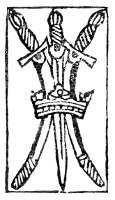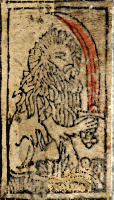Italian renaissance woodcut playing cards
About the pip cards in the suit of spade
The Cisalpine playing cards fall into three families,
confusingly named after three nations while their distribution does not
follow the borders of the corresponding nation states. Italian
cards were originally used in northern Italy – today only in the
northeast, as French cards (a Transalpine style) have
replaced them in the northwest. Portuguese cards were used in
Portugal, southern Spain and southern Italy, but are now extinct.
Spanish cards were originally only used in northern Spain, but
have later replaced Portuguese cards everywhere except in
Portugal, where French cards eventually took over.
Among the distinctions between these three families, the
representation of the pip cards of swords and batons/clubs are among the
clearest. Italian cards preserved the Mamluk
representation of swords, having curved swords divided in two equal
groups, plus a single straight sword for the odd numbers. The groups
cross each other at two points where they either interlace or are
covered by an ornament. Portuguese cards divide them likewise,
but represent them by long straight swords crossing in the center of the
card. In Spanish cards, the swords are short and straight, and
distributed without touching each other, like cups and coins. For the
descendant of the Mamluk polo-sticks, Italian cards have
straight and smooth ceremonial batons crossing in the center like
Portuguese swords, while Portuguese cards substitute
rougher branches of wood placed in the same layout. Spanish cards
have even rougher short clubs treated like the swords.
The present group of cards conform to the Italian conventions
in most aspects, but have a unique treatment of the pip cards in the
suit of swords. In the three packs where they are present, they are
curved with the hilts and tips of each sword pointing to the same long
edge like normal Italian swords, but overlapping only in the
centre like Portuguese ones – though not crossing like these. In
the tarot cards, the swords pass through an open crown (circlet) which
cover the overlapping area. The Fournier cards are identical apart from
having the left and right edges trimmed away in order to fit on the
narrower cards. The Bassano and crude
packs instead has a band of
cloth wrapped around the central area. As the pip cards of batons in the
reversed
pack are identical to those in the Fournier cards
(except for being reversed), it seems reasonable to assume that the same
is the case for its lost pip cards of swords.
This leaves the elegant
pack, which does not have any preseved
pip cards of this suit. However, its ace of swords complements the pip
designs in the tarot and Fournier cards much better than the very
different aces present there. It has a straight sword, similar to the
central ones in odd-numbered pip cards (but more detailled and
upward-pointing) passing through an almost identical crown. Apart from
making it highly likely that the elegant
pack's pip cards in this
suit was identical to those in the Fournier cards, the significance of
this lies in the light it shines on the probable origin of the unusual
pip cards. In contrast to these, the ace is very typical of
Italian designs, in particular the Bergamasche
and tarot de Marseille patterns (all aces in the
elegant
pack conform to one of these).





Thus, it has to be the ace that is the inspiration for the pip cards
and not the other way round. Most of the non-tarot cards have designs
which clearly are copies of a slightly wider original, but the preserved
tarot pack cannot be the source of the elegant
pack’s ace with
its older and more widespread design. A lost pack, presumably a tarot,
must therefore be postulated. This would have had aces like the
elegant
pack but the proportions and the pip cards of the
tarot.